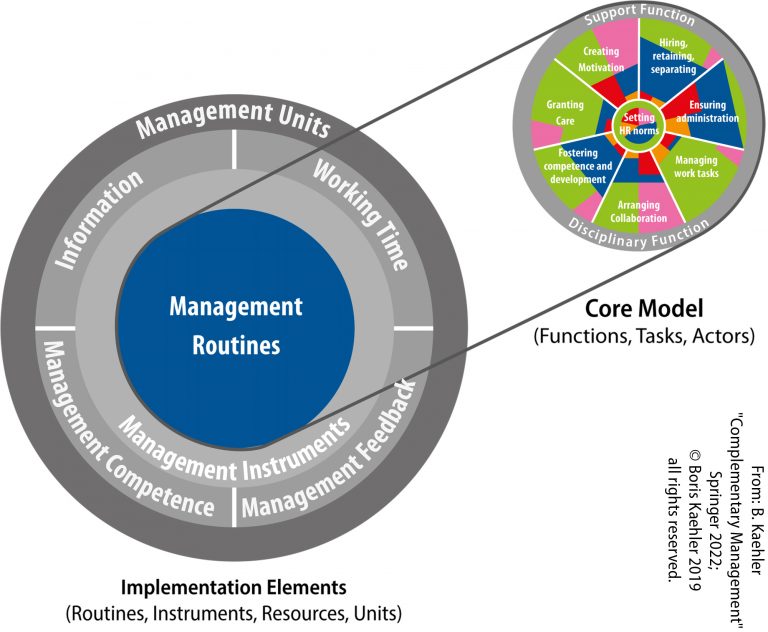The Four Implementation Elements
Implementing the core model of Complementary Management requires four further model elements.
Synopsis of the three core elements
The Complementary Management Model includes four implementation elements: management unit design, management routines, management instruments and management resources. The systematic relationship can be summarized as follows: Managers fulfil management tasks (e.g., performance feedback) using management routines (e.g., interviews), apply management instruments (e.g., work schedules), require management resources (e.g., business information), and do all this on the basis of the management unit structure (e.g., the design of their job).
Management Routines
The management routines, understood as concrete activities, serve as a way to implement the management tasks. For example, performance feedback is initially only an abstract task that must be implemented in regular employee dialogs, among other things. A distinction must be made between annual routines (e.g., annual employee reviews), continuous routines (e.g., weekly work dialogs) and on-demand routines (e.g., crisis interventions or hiring projects). The theoretical basis of this element of the management model is the established construct of organizational routines. Those for whom the term has a negative connotation (in the sense of getting stuck in a rut) may replace it with “management activities”. Organizations should clearly define which management routines are to be performed, which actors are involved, and what the frameworks are. The shares each actor has in the routines add up to the totality of their people management activities. This puts management responsibilities into very concrete terms: Has an actor actually carried out the routines incumbent upon him or her and thereby achieved the defined management tasks? If, for example, a line manager does not conduct regular work dialogs, he or she is simply neglecting his or her professional duties.
Management Instruments
Within the framework of management routines, management actors use the management instruments available in their respective companies. These are formalized tools that support employee management and leadership, in particular, rules, systems, programs and forms. The conceptual differentiation between routines and instruments has significant implications. Leadership and management are not exercised through the instrument (e.g., a salary system or appraisal procedure), but always through its specific application. Good instruments are sometimes devalued by their inadequate use in everyday management. Conversely, dysfunctional and poorly designed HR instruments can be relativized in the course of their application and misguided decisions can be avoided – a question of management quality and certainly also a question of the internal distribution of roles. Above all, however, it becomes clear that HR instruments must be designed in such a way that they effectively support day-to-day people management and leadership.
Management Resources
In the Complementary Management Model, the implementation element of management resources represents a purely pragmatically reasoned selection of management prerequisites critical to success. In practice, leadership and management often fail because of four essential problematic resources – so much so that it is worth highlighting them prominently by means of a separate element. First: the working time required to perform management routines, which many leaders do not have or do not take. Second, management competencies are required. These consist of action competencies (i.e., skills to successfully perform management routines), which in turn are based on non-managerial elemental competencies (e.g., communication, analysis, assessment, decision-making). Third, management actors need comprehensive directional and situational information. And finally, holistic management feedback is required. All four resources are necessary to enable effective people management and leadership in the first place.
Management Unit Design
The management unit design encompasses the organizational structures in which the various management actors are integrated. This relates to the structure and hierarchical integration of the organizational units involved in people management and leadership (jobs, groups, departments, divisions, etc.). However, the distribution of tasks among the actors and their respective powers are also connected with it. The general principles of organizational science form the theoretical basis here. The management unit design, like the other elements of the model, does not represent a sub-area of leadership, but provides a special perspective on leadership and management. Thus, it cannot be considered separately from the overall model. Influencing processes certainly take place without permanent management structures, but this has little to do with systematic organizational leadership and management. The Complementary Management Model leaves room for different distributions of tasks among the actors, but its elements provide a rough structural framework. For example, a human resources department that refuses to accept compensatory “HR co-management” would not be compatible with the model. The same applies to management positions without disciplinary authority or with an overstretched management span. Functioning people management and leadership requires a functional management unit design.

